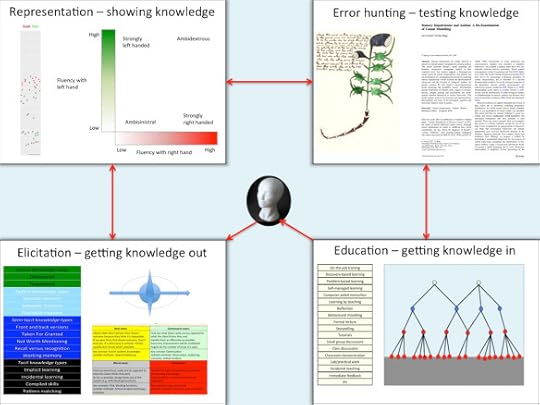150 posts and counting
By Gordon Rugg
This article is an overview of our blog articles so far, and of what is coming next.
 Image copyleft Hyde & Rugg, 2014
Image copyleft Hyde & Rugg, 2014
The knowledge cycle diagram above shows how the main themes of our work fit together.
We’ve now blogged about all of these themes, and about how they fit together. For some themes, such as elicitation, we’ve covered the main points fairly thoroughly. For others, we’ve only sketched out the key points so far; we’ll be covering those themes in more detail in later articles.
This article gives an overview of what we’ve covered so far, with links to some key articles. The links aren’t an exhaustive list, but they give a reasonable sample of the type of work we’ve been doing.
There are four main themes in the knowledge cycle, as follows.
One theme is elicitation: getting knowledge out of people. We’re particularly interested in knowledge that people find difficult to put into words, where questionnaires and interviews simply can’t tackle the problem. A lot of our work involves eliciting and clarifying requirements for products and services; we’re also interested in the mirror image of this, namely design of products and services that meet user’s requirements.
Some articles about elicitation and requirements:
Finding out what people want, in a nutshell
A unified model of requirements gathering
Why clients change their minds, and what to do about it
How to tell if you’ve met a client’s goals
Are client requirements infinite and unknowable?
A set of articles about client requirements, in eight parts: Part 1, 2, 3, 4, 5, 6, 7, 8
A tutorial article on card sorts
A tutorial article on think-aloud technique
A tutorial article on self-report and related techniques
A tutorial article on structured observation of the environment
Some articles about design:
Making designs interesting
Parsing designs
Skeuomorphs – when a product is designed to look like something else
Designing for efficient use of space
An introduction to user-centred design
A worked example of design rationale
Our future articles on this theme will mainly be more detailed examinations of topics that we’ve already touched on.
A second major theme is representing knowledge – how best to visualise and categorise it. The Search Visualizer software is an example of how this can provide new ways of handling long-running problems. We’ve also looked at categorisation and classification, applied to a range of areas that include gender categorisation and use of space.
Some articles about representing knowledge:
Schema theory
Graph theory
Binary categorisation
Facet theory
Visualising categorisations of gender
Game theory
Systems theory
We still have quite a lot to write about this theme, both at the level of broad organising principles and of detailed nuts-and-bolts articles.
The third main theme is testing knowledge. There are large and well-established literatures on human error, logic, etc, that we’ve treated as foundational for our work – we haven’t tried to re-invent the wheel.
Our work in this area has concentrated on case studies where we’ve applied the Verifier framework to long-standing problems, such as the Voynich Manuscript and the literature on autism. In both those cases, we’ve published articles in the top relevant journals, as a way of checking that our findings provide solid new insights.
Some articles about modelling and testing knowledge, and about human error:
Practical issues for anyone trying to hoax something like the Voynich Manuscript, in eight parts: Part 1, 2, 3, 4, 5, 6, 7, 8
A series with Gavin Taylor about the D’Agapeyeff Cipher, in five parts: Part 1, 2, 3, 4, 5
Game theory
Systems theory
The mathematics of desire
Worldviews, and what people really want
Cherry-picking and use of evidence
Education and concepts of “natural”
Our future articles in this area will mainly be about unifying principles, about what people desire, and about how those desires skew our perceptions and judgments.
The fourth major theme is getting knowledge in to the human brain, thereby completing the knowledge cycle. Our work here has so far focused on filling gaps in the existing education literature, principally in two areas. The first of these is types of memory, knowledge, skill, etc, with particular reference to semi-tacit and tacit knowledge, and to the implications of these for delivery and learning methods. The second is the crucial distinction between serial processing and parallel processing/pattern matching, which has enormous implications for teaching and learning, but which appears to have received little attention in the education literature.
Some articles about education:
Life at university, part 1
Passive ignorance, active ignorance, and why students don’t learn
Connectionism, neural networks and mental processing
Models of knowledge with relation to teaching
Evidence-based approaches and education
“Natural” and “artificial” learning
Are writing skills transferable?
How complex should models of education be?
The limits to literacy
An education framework based on knowledge modelling
We’ll be blogging about this in the future both at the level of detailed articles on specific topics and at the level of big-picture overviews.
Future articles
Some articles due to appear over the next few weeks:
A series of articles on the realities of life at university, for students
A guest article by Gavin Taylor about visualising teaching plans
Non-verbal wayfinding and signage
More about design
More about how people’s views of the world are structured
In addition, as usual, we’ll be blogging about a wide range of interesting concepts that we’ve encountered in the byways of research.
Notes
You’re welcome to use Hyde & Rugg copyleft images for any non-commercial purpose, including lectures, provided that you state that they’re copyleft Hyde & Rugg.
There’s more about the underlying theory in my latest book, Blind Spot, by Gordon Rugg with Joseph D’Agnese
http://www.amazon.co.uk/Blind-Spot-Gordon-Rugg/dp/0062097903


Gordon Rugg's Blog
- Gordon Rugg's profile
- 12 followers



